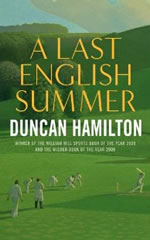A Last English Summer
Martin Chandler |Published: 2010
Pages: 367
Author: Hamilton, Duncan
Publisher: Quercus
Rating: 4.5 stars

A leisurely stroll around a season’s cricket has always been a popular choice for writers. Accounts of tours, the more so in the days before such visits became so truncated, could sometimes be as much like travel books as cricket books. In a slightly different vein a number of cricketers have, from time to time, published their season’s diaries, taking their reader around the county circuit. A further variant on the theme that has emerged in recent years is the match by match account of the Champion County’s season, usually appearing in time for the Christmas market. By their nature these projects concentrate on an individual team or cricketer but, as here, just occasionally a similar approach gives rise to a completely different kind of book.
Duncan Hamilton spent the summer of 2009 travelling around England. He took in something of all forms of cricket including, from outside the county circuit and the international game, a Lancashire League encounter and the NPower Village Cup final, as well as a day at the cradle of the game. He took his inspiration from a book by Geoffrey Moorehouse, The Best Loved Game, which was the result of Moorehouse undertaking a similar exercise in the immediate post-Packer season of 1978. Hamilton gave the, by 2010, fundamentally changed Eton v Harrow fixture a miss but that apart, taking into account 30 years evolution of the fixture lists, his journey followed what would have been to Moorehouse, had he lived to read about it, a familiar route. To give a clue as to their purpose both men watched Hambledon in the course of their travels, although only Moorehouse went to Broadhalfpenny Down. In 2010 cricket is still played on that historic sward, albeit not by the Hambledon club itself, but by Brigands Cricket Club, and Hamilton, choosing the historic club over the historic setting, had to go to a different ground nearer the village centre.
The matches that Hamilton attended are largely incidental to the main thrust of his book which is to take an opportunity to look back at the way the game has been played in England. His personal experience of serious cricket watching began, by remarkable coincidence, on the same day as my own, Thursday 27 August 1968 when, after a downpour that appeared to have washed out all hope of a result, the remaining spectators famously helped the ground staff to get the playing area at Kennington Oval ready for Derek Underwood to send the Australian batsmen to their doom and level that year’s Ashes series. That said Hamilton’s thoughts most certainly do not just extend to what he has seen and the various chapters contain digressions that stop off at points throughout cricket’s history.
When Hamilton finally gets around to writing about the match he is concerned with, generally at about the half way point of the relevant chapter, he demonstrates a thorough understanding of how to bring a game to life. You will not find here any bland sentences trotting out what is obvious from a glance at the scorecard, and everything that is written adds something to what has already been said. In that respect I was, having recently had the pleasure of reviewing Of Didcot and the Demon, reminded of the skill of the late Alan Gibson and his priceless ability, shared by Hamilton, to write about “a day at the cricket”, rather than “the day’s cricket”.
It is not just the way the game was played in years gone by that Hamilton’s book harks back to. His writing, particularly by virtue of his liberal use of similes and metaphors, contains many shades of sepia and has much of the romanticism of Cardus about it. Batsmen and bowlers today have their technical faults ruthlessly exposed by skilled cameramen and expert commentators and that, as much as anything, accounts for the change in the basic style of cricket writing that we have seen in recent years. A Last English Summer demonstrates that there is still a place for old fashioned descriptive writing.
Were it just for its core contents this would be an excellent book but there are other features that deserve to be noticed not least of which is a most attractive dust jacket. The book also enjoys that relative rarity, a detailed index, as well as two rather lengthier additional features. First is what is styled a postscript and which consists of a summary of what has happened to the game itself, and to the current players whose fortunes were dwelt on in the body of the book, subsequent to the close of the 2009 season. It is rather unexpected, and confirmation of how much the pace of change in the game has accelerated in recent years, that this runs to as many as 24 pages. In addition there is a statistical summary of the 2009 season. I must confess that my immediate reaction to this was to question why it needed to be so long, running as it does to almost 50 pages. The level of detail was certainly unnecessary in the context of the rest of the book but, once I got over the surprise of how thorough it was, I must confess I rather enjoyed it – with my eye for trivia I noticed one delightful statistical absurdity that demands the question “What links Owais Shah, Stuart Law, Nick Compton and Ed Joyce?” Now it is not, of course, worth buying a book just to find out the answer to a question like that – you buy a book for the quality of the narrative, but if this review has not convinced you of the need to procure a copy of A Last English Summer I have no doubt that the extracts that Hamilton and his publisher have kindly allowed us to feature here will do.






Leave a comment